The Castle – History of University Hall
Extracted from the University Hall 50th Anniversary commemorative book published by University Hall Alumni Ltd. in 2007
The history of the castle standing on top of the path at 144 Pokfulam Road began on 7th October 1818, when a baby boy was born to George Rankine Lapraik and his wife Susan in London. On 2nd March 1819 the baby was baptized Douglas at the Scotch Church on London Wall, a short street in the heart of the City of London. Today, the church is gone. Probably, like so many others, it was destroyed during the Second World War, when London was subject to much bombing.
“Lapraik” might have originated from the name of a Scottish place, Lickprivick, and mean “the pear farm”. The Lickprivick Castle used to stand in East Kilbride, now known as Greenhills, in Renfrew, Scotland.
In 1839 or so, the young Douglas Lapraik went to Macau, then a small town with a Portuguese settlement at the mouth of the Pearl River, to become an apprentice to the watchmaker, Leonard Just. Also originated from London, Just had been in Canton and then Macau for over 10 years. Just’s firm was named “Just & Son”, although his son, Leonard Junior, was only an apprentice of his.
In 1842, following the defeat in the First Opium War the Qing Dynasty ceded Hong Kong Island to Britain. In the same year, Douglas came to Hong Kong, apparently without cutting off ties with Just. In 1846 Just branched to Hong Kong, as he established shops in D’Aguilar Street and Queen’s Road. Gradually, Just rooted out his business and home in Macau and moved to Hong Kong.
 Douglas Lapraik
Douglas Lapraik
With the rapid expansion of the town in Hong Kong, it did not take long for Douglas to realize that there was money to be made beyond clocks. Like the taipans of the day such as Jardine and Dent, he started to move into estate agency, trading broker and trustee and dealt in many properties, as buyer, seller, mortgagor and agent. There was indeed money in those trades, and he managed to gain fame while gathering much wealth. His bonds were repeatedly accepted by the Government and he became a popular arbitrator. Such was his reputation as a fair and wise man that on one occasion, when a party nominated Smale, the Attorney General, to be the arbitrator and the other Douglas, Smale deferred, saying that Douglas possessed the knowledge of law equaled to that of many lawyers.
One of the businesses Douglas engaged in was shipping, which he might have started in a dramatic way. He was reported to be one of the investors of the famous junk, Keying. The boat was purchased from a merchant in China by a group of British merchants who, in order to avoid being caught in the business, disguised themselves as Chinese. After repairs in Hong Kong, in December 1846 Keying set sail to Britain. It was probably the first Hong Kong boat to embark on the long journey, for the Governor, John Davis, and other dignitaries saw its departure fondly. Three months later, adverse weather and shortage of food and water led to a mutiny on board, and the captain sailed Keying to New York. Arriving New York in July 1847, it soon became a popular exhibition that received thousands of visitors. In February 1848 it finally set sail to England. A month later, it reached its desired destination, London, where, again, it was admired by thousands of visitors, including none other than Queen Victoria. However, Douglas claimed that he received not a cent’s return from his investment.
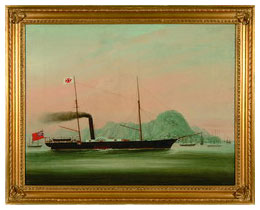
Around 1850 Douglas started a shipping service to Amoy, Foochow and Swatow which was so well run that it became a near monopoly and, probably due to the emigration rush to California and Australia, where gold was recently discovered, a huge success. The business brought him wealth and the eagerness to make it even bigger. In 1853 Hong Kong saw its first steamship, Queen, a wooden boat of 137 tons, which was built by John Lamont for Douglas. It has been reported that the Queen was deployed by Commodore Perry to combat pirates and indirectly back up his fleet of black ships to Japan. Another famous ship acquisition Douglas made that year from Lamont was the “Bob Roy”, a run down ship. Douglas spent lots of money to have the ship repaired, before renaming it “Australia”. Just as he was about to set the ship out for long haul journeys, the original owner sued to recover it. The court battle dragged on as the court in Hong Kong ruled against Douglas. The Privy Council eventually ruled in favour of Douglas, but only in 1859.
In 1855 Douglas leased a piece of land in Shek Pei Wan in Aberdeen for the purpose of a large dry dock to service warships of Britain and other countries. The rent was ₤100 per year and he was committed to constructing the dock within 18 months.
In 1858, John Steward Lapraik, 17 year old son of Douglas’ eldest brother, came to Hong Kong and joined Douglas’ business. John Steward was to be a successor to Douglas eight years later.
Douglas initially intended to build his dock through a joint stock company owned by shipowners but later decided to do it with Lamont, who was running a successful neighbouring dock. In May 1860 Douglas gave up his lot of undeveloped land to the Government so that it could be granted to Lamont to build an extension of his dock.
In August 1861 Douglas was one of the founders of the Hong Kong Chamber of Commerce, which embarked on persistent petitions to the authorities in Hong Kong, Britain and China for improvements to facilities for Hong Kong traders.
Naturally, wealth drove Douglas into improving his accommodation and he thought about building a house of his own. In 1860, the Government had decided to build a reservoir in Pokfulam, a valley in the south side of Hong Kong Island. To be coupled with miles of conduit pipes, the reservoir was thought to be the answer to the water supply problem. He set his eyes on the hill by the entrance to the road to the reservoir under construction. The hill commanded panoramic views, not to mention close proximity to water supply. The road to the land began in Sai Wan, the Western District of today, and led to Aberdeen, where Douglas was planning to set up his docks. In about 1861, he obtained a 75 years lease from the Government for the hill and set about building on its top a small castle. Known as Rural Building Lot 32, the land had a registered site area of 310,227 square feet.

In 1862, Lamont contacted the British Admiral with a proposal to build a new dock that would be large enough to service the warships in the British Navy, in the process asking for a loan. The proposal was quickly accepted by the Admiral who procured the British Government to lend₤3,000 to Lamont. This encouraged Lapraik to take the lead in forming an alliance with the other two major shipping concerns in the region, P & O and Jardine Matheson. On 1st July 1863 the Hongkong & Whampoa Dock Company was formed, with Thomas Sutherland, the head of Jardine’s, as the first Chairman and Douglas as the Secretary. So notable was this event that it prompted the Government to start writing the Companies Ordinance. The company was the first limited company registered in Hong Kong.
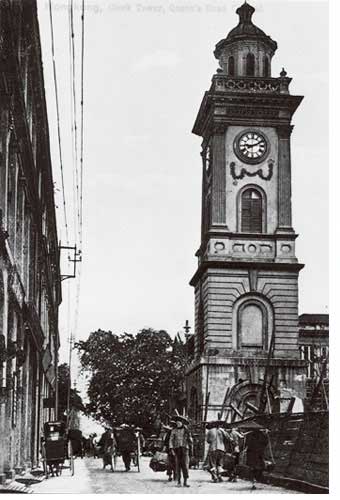
Also in 1862 Douglas donated substantially for a tall clock tower at the junction of Pedder Street and Queen’s Road, which could be seen from the harbour. The clock tower sounded for the first time on New Year’s Eve (31st December 1862), ushering in 1863, and became such a landmark that many people at the time simply called Pedder Street “大鐘樓” (the “big clock tower”). This landmark was to stand there for over 50 years, until 1913. More below.
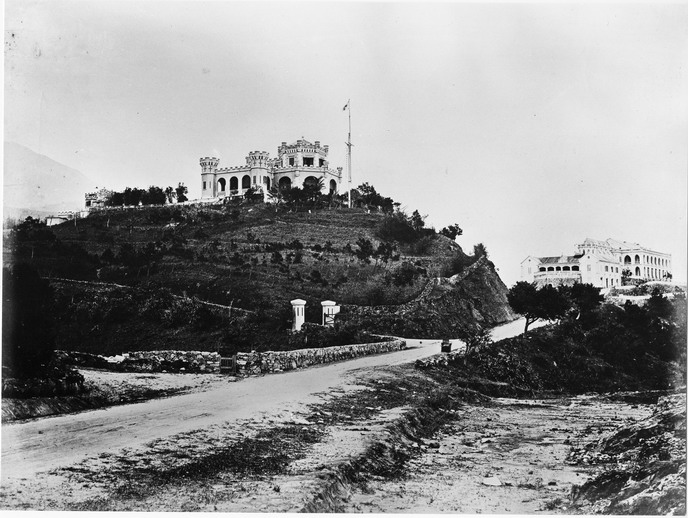
Back to Douglas Castle. When completed, probably in 1864, it was a compound composed of a single-storey house featuring an octagonal penthouse bedroom that commanded excellent 360∘hill and sea views, with an octagonal side house and a rectangular outhouse. As Douglas was only a single man in his mid-40s whose love and hobby lied in his numerous business ventures, Douglas Castle provided him very comfortable accommodation. However, he did not spend much, if any, time in Douglas Castle. Despite the promising business ventures he had at hand and the assets he had accumulated, he retired to Britain in 1864, prompted apparently by health problems. His many friends offered to throw him a farewell party but he declined, saying that it was not his character to go to such a party. The press reported the incident with much admiration:
“… a public dinner was about to be given to Mr. Douglas Lapraik on the occasion of his going home to England, after having resided in China for upwards of a score of years, but was modestly declined by that gentleman as being entirely foreign to his habits and wishes. The Hongkong people are not much given to public dinners, and we need not be surprised if strangers should inquire into the reasons for entertaining Mr. Lapraik. We think we can answer this inquiry, and explain why such an exception should be made to the general rule.
“Mr. Douglas Lapraik has never been a party man, and has consequently paid no attention to the fact that China society is divided up into small cliques and coteries. He has respected everybody who has the smallest claim to respect, and this feeling on his part has been felt by everyone to be perfectly sincere and genuine. No one who knows Mr. Lapraik – and who is there in this Colony who doesn’t – has ever imagined that he was actuated in his behaviour by selfish motives. Although he is wealthy, he never measures himself by the amount of his wealth; and … does not measure other men by the amount of theirs. … Mr. Lapraik’s conduct and general bearing has been at once a public rebuke and a public example. Unfortunately, no man has had genius enough to imitate him, or sufficient daring to ape him.
“We sincerely trust that he will be both able and willing to return to this Colony in the course of eighteen months. His influence here is not small, and we do no think it has ever been misemployed. This is saying a great deal; but we should like to see the man who would venture to think it was saying too much.”
The last paragraph of this report suggests that Douglas was unwell at the time.

When he left Hong Kong for Britain in April 1864, Douglas was 45 years old and had been in Hong Kong for 22 years. Although his wealth was mostly here, ill health prevented him from returning. Like his customers, he probably engaged agents to look after his assets for him: the probate to his estate listed only two small properties, when he was quite a land investor. In December the same year, Douglas’ nephew, John Steward, married Clara Silk Thompson in Hong Kong.
In April 1866, Douglas closed down his watchmaking business and transferred it to George Falconer, with whom he had served apprentice under Just. Renamed to Falconer & Co. by George Falconer, the firm continued to prosper and to remain in the management of the Falconer family until it was sold to the Lee Hing Group in 1997. Today, Falconer Jeweller is a busy jewellery shop in the prestigious Peninsula Hotel.
In July 1866, after procuring the establishment of the Hongkong Hotel Co., Ltd., Douglas went into retirement, as he formally entrusted his business operations to some friends and his nephew, John Steward. In the same year, John Steward had a son, John Douglas, and took over the Secretary position at Hongkong Whampoa Dock Company.
In early 1867, Jane, niece of Douglas, got married to Robert Ellis Baker in Hong Kong. In August that year the middle-aged Douglas – then about 50 years of age – got married to Jessie Hearn, daughter of Carisbrooke Castle in the Isle of Wight. In the same year, John Steward had his second son, Thomas Steward.
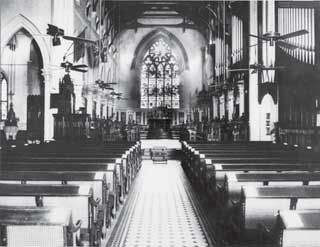
The marriage of Douglas and Jessie lasted less than 2 years – on 24th March 1869, Douglas died. He was recorded to be a resident of “Oaks”, Acton, Middlesex, a suburb in today’s London. In his will, Douglas bequested his assets and properties to nephew John Steward, son-in-law Robert Ellis Baker and associates William Lane and Robert Manger, after provisions for Jessie. Douglas left no children, although he and his nephew John Steward were probably as close as father and son.
In memory of Douglas, John Steward, spent £1,000 to erect a stained glass east window depicting the Ascension and crucifixion of the Lord at St. John Cathedral in 1870. The beauty of the window can only be admired from this newspaper report: “The upper parts of the lancets are occupied by the Blessed Virgin and twelve Apostles witnessing Ascension of our Lord, whose figure, surrounded by angels, fills in the rose window, below, and extending across the whole of the cnetre part of the five lights, is the Crucifixion. Under this again are four “types” of a true sacrifice, the Secrifice of Abel, of Abraham, of Melchiasdek and Noah; the central opening being occupied with a type of the Ascension.”
Unfortunately, the window was destroyed during Japanese Occupation.
Under the able leadership of John Steward, the shipping arm of Douglas Lapraik & Co. flourished. The company had its wharf in Victoria, called Douglas Wharf, which probably gave a nearby street its name - Douglas Street. John was apparently a keen property investor like his uncle, so much so that in 1876, Douglas Lapraik & Co. was the largest private landowner in Hong Kong: the firm paid HK$11,108.92, compared with Jardine’s HK$8,453.40.
On 28th July 1883, the 12th limited company in Hong Kong - Douglas Steamship Co., Ltd. - was started by John Steward to take over the business of Douglas Lapriak & Co. Like a typical successful business today, in 1892 the shipping company merged with Francis Cass of Amoy and Dodd & Co. of Tamsui, with John as its founding Chairman. Following the publication of a prospectus, the enlarged company became even larger, as new investors subscribed for HK$1 million new share capital.
More focused than Douglas, John Steward had his share of fame as a successful businessman. Apart from running the busy operations at Douglas Steamship Co., Ltd. and Hongkong and Whampoa Dock Company, he was a director of the Hongkong and Shanghai Banking Corporation.
So much about merchants for the moment. The Société des Missions Entrangères was established around 1660 with the mission to train French Catholic missionaries to bring the “Good News” to the East. The spread of Catholicism in Asia was well under way, with hundreds of thousands of people in Vietnam and Japan having been converted, and the good work of the mission, commonly known among non-French speakers as “the French Mission”, would go a long way to spread Catholicism around the world.
Under the leadership of Father Libois, the French Mission started to operate in Hong Kong around the same time as Hong Kong became a British colony. In 1856, the young Father Osouf came over straight from Paris to replace Father Libois, who was to be transferred to elsewhere in Asia. The French Mission occupied a large house on Staunton Street, then an area inhabited by many European families. In the French Mission house were a number of bedrooms for the accommodation of sick missionaries who came to Hong Kong for medical treatment.
In 1873, the French Mission decided to accept the recommendations by Father Osouf that a sanatorium be set up in Hong Kong. In June that year, the French Mission purchased from J. J. dos Remedios a piece of land in Pokfulam for the sanatorium which was to be called “Béthanie” – after the village Jesus visited before his Passion. In October 1875, the Bethanie was completed and received its first group of sick missionaries. In the course of the next 100 years, the sanatorium was an essential facility to the French Mission, there having been 6,000 visits by sick missionaries from all over Asia.
In 1884, the French Mission decided to establish a house of retreat for their tired missionaries and entrusted with this task to Father Rousseille, one of the most learned and experienced senior members of the ruling council. The idea was for this house – to be called “Nazareth” – to serve as a nest for missionaries to have brief retreats and rekindle their religious fervour through prayer and meditation.

In April 1885, the French Mission purchased the “Clanmore”, a European house, from Butterfield and Swire. Known to local villagers as 太古樓“Taikoolao”, this house was located in where the Pokfulam Garden is today. After a bit of renovation work, the house became the Nazareth. In 1886, at Nazareth a two-storey house was built for the French Mission’s printing press.
In 1888, a number of residents of the Nazareth at Taikoolao, including Father Rousseille himself, were subject to a mysterious fever. The fever was localized in Clanmore and none of the experts consulted could tell what caused it or how it could be stopped. By 1890, Father Rousseille had to decide to relocate the Nazareth. One of the locations he thought of was Douglas Castle, but John Steward Lapraik refused to sell.
Eventually, to get away from the mysterious fever the Nazareth community was moved to Richmond Terrace in Kennedy Town in April 1891. Before long, Richmond Terrace was found to be too small – there was no space for a chapel and the printing workshop, with its growing “business”, was in bad need to expand.
On 13th July 1893, John Steward Lapraik died from heart disease at the age of 54 years. Probate of his estate was granted on 16th May 1894 to his son John Douglas and it was recorded that the estate had assets and cash to the total value of HK$1,420,728.15, an astronomical figure.
In 1894, following a phenomenally cold January, when the whole Peak was said to have been ice-bound for three days, Hong Kong suffered from bubonic plague. On 10th May 1894 Hong Kong was declared an infected port. Thousands of lives were claimed by the plague and perhaps half of the population – 100,000 people – left Hong Kong. This was probably the reason why those managing the estate of John Steward were quick to sell Douglas Castle to the French Mission, thus giving Nazareth the ideal location. Given the stone Douglas Castle was still in good shape – it was less than 30 years old - Father Rousseille decided to build a new wing, chapel and printing house to the north-east of the castle, at a total budget of HK$60,000. Danby, Leigh and Orange were engaged to be the project architect.
On 24th May 1896 the new wing was completed and the Nazareth community moved into its new home. In January 1897 Father Rousseille reported on the new Nazareth as follows:
“… All the construction work was supposed to have been completed by 1 March, but we had to wait until 24 May 1896 to take possession of our cells and it was not until 27 October that the chapel could be opened for worship. On that very day, the 232nd anniversary of the foundation of our Paris seminary, the solemn blessing of this oratory took place under the name of ‘Holy Family of Nazareth’. Since then, our brothers have no longer had to walk over to Béthanie to say their daily morning masses, twelve altars having been installed in the crypt. The house comprises 25 bedrooms, a refectory and a library which serves also as meeting room. Building materials from our first abode (Clanmore) have been re-used for the present one. Everything is quite plain. It is true, however, that the old castle which now forms part of it, the verandahs which surround it, and above all its location upon a hillock rising between the sea and a fresh water reservoir, project an image which is a little too conspicuous. However, this was unavoidable. Our Printing Press building, which was ready for use a year ago, was erected in the continuation of the chapel. In Hong Kong, it already enjoys a rather overdone reputation. As with the crypt and as with the chapel, we owe it to the generosity of benefactors for whose eternal life we pray to God twice a day. As you can see, we now can welcome missionary brothers who will want to come in desertum locum et requiescere pusillum (‘come away tome some lonely place all by themselves and rest for a while’). This year we have already had up to 16 members of our Society stay together at the same time at Nazareth.”
For 90 years, Nazareth provided an excellent location for prayers and work for the French fathers. A day in the life at Nazareth:
“The morning bell rang at 4:45 a.m. At 5:15 the Fathers recited the “Angelus” together in the Chapel and then the “Veni Sancte Spiritus” which commenced their mediations. These mediations were carried on in the chapel or elsewhere, ab lib. The “Sub tuum” which ended mediation at 5:45 was recited in the chapel by all. After mediations masses were celebrated either in the chapel or in the crypt where each Father had a special altar reserved for him. After mass, followed by thanksgiving, the Fathers moved to the refectory to have their “frustulum”, or breakfast, which had to be eaten within a quarter of an hour. At 7:30 the Fathers assembled in the chapel to recite together the canonical offices: Prime, Terce, Sext and Nones. When there was conventual mass, the recitation of Prime and Terce took place beforehand and Sext and Nones afterwards.
“After the canonical offices, the Fathers began work editing, translating, proof-reading or printing. At 11:45 there followed a period devoted to the reading of edifying literature, usually in the Library. This ended at mid-day with the Angelus, which was recited by all. Next the Fathers retired to the refectory. After tiffin, the Grace. Tiffin was followed by an optional period of recreation until 2 o’clock. At 2 p.m. the Fathers recited Vespers and Compline together in the chapel followed by self-examination. On leaving the chapel the Fathers started work once more. At 4:30 p.m. they recited together the Matins and Laudes. After the recitation of Matins and Laudes there was time for recreation or walking, if desired. The Nazareth Fathers were permitted to visit their brethren at Bethany. Dinner was at 7 p.m. It was followed by communal recreation and this was compulsory until 8:15. At 8.30 the Fathers assembled in the chapel for the repetition of the Angelus and evening prayers. After 9 p.m. total silence was compulsory in all parts of the house. The Fathers were expected to keep complete silence. When one went to bed was optional.”
Around the start of the 20th century, the Nazareth went through a major renovation, as the old Douglas Castle building was substantially rebuilt. Of the Douglas Castle, two side towers and six steps remain to this day - perhaps intentionally on the part of the French Mission?
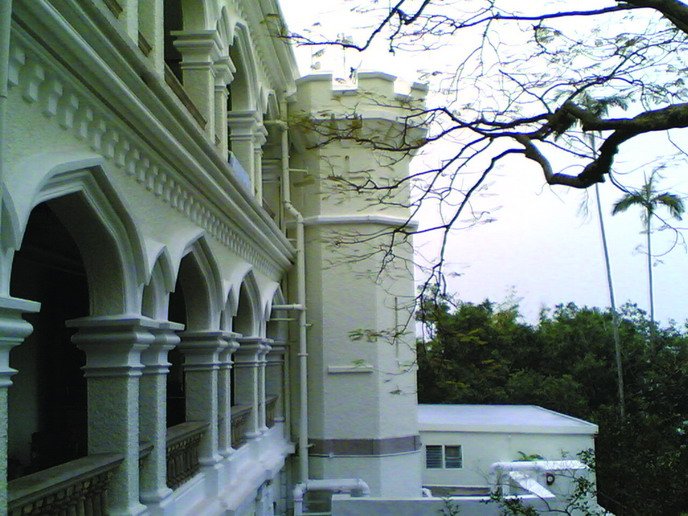
The Douglas Steamship Co., Ltd. was one of the most successful shipping companies in Asia, with busy routes on the Pearl River and Taiwan. In Taiwan, such was the popularity of the company that the government of the day somehow saw fit to give subsidies to other shipping companies in order to ensure competition. Unable to beat such unfair competition, the company pulled out of Taiwan in 1905.
In 1913, the clock tower donated by Douglas was demolished to facilitate road widening and the clocks were sold by public auction. In 1916, up to three of the clocks were fitted to the clock tower at the railway terminal in Tsimshatsui. Replaced by a composite bronze clock with four faces six years later, the whereabouts of the Douglas clock are unknown.
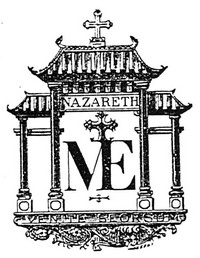
Under the leadership of the workaholic Father Monnier, the printing house at Nazareth was a very busy operation. Supervised by half a dozen or so editors, forty to fifty workmen labored like bees around the latest printing machines at the time. Father Monnier spent 40 years in the Nazareth to make its printing press one of the busiest of its kind in Asia, with publications in 28 languages. He retired from the Nazareth in 1924 and, after a visit to India, returned to Hong Kong to stay at the Bethanie until his death in 1939.
In 1941 the Second World War spread to Hong Kong, as Japanese army invaded and quickly crushed the small and much lesser armed resistance here. The first Japanese troops reached the Nazareth on the day following the invasion and they literally robbed everything in the premises. Although a few of the French Mission fathers were allowed to stay in Nazareth, the Japanese authorities requisitioned the printing press, thus suspending an essential operation of the French Mission. In 1945 the Second World War concluded and the French Mission regained the Nazareth, but it was not until 1948 that the printing press there resumed its operation.
With the Lapraiks leaving Hong Kong shortly after the death of John Steward, Douglas Steamship Co., Ltd. was taken over by Stuart Taylor Williamson in the 1920s. The company took part in the Second World War as its ships, Haiching, Hai Hong, Haitan and Haiyang, were requisitioned by the Allied Forces, although Williamson was confined at Stanley Prison. The company re-activated its business after the war but its control changed with the sudden death of Williamson on 5th September 1950. Williamson’s trustee, John Robertson Mullion, then became the Chairman. At the time, tycoons Robert Ho Tung and John David Alexander were also directors and shareholders in the company.
The change of government in Mainland China after the Second World War made it difficult for overseas missionaries to stay there. By the early 1950s, most of the foreign missionaries had to leave Mainland China. Although the tremendous population growth in Hong Kong led to rapid increase of Catholics, the French Mission found that its missionary work could no longer be conducted as before and that while there was much demand for the facilities at Bethanie, the Nazareth would have to be closed down. In 1953, through Messrs. F. Zimmens, solicitors, the French Mission approached the Government with an indication that the Nazareth was available for sale. Having sketchily considered a number of options, the Government decided that it would have no use of the Nazareth and the University of Hong Kong seized the opportunity to acquire the land. On 4th December 1954 the University purchased the property from the French Mission at the price of HK$1,600,000.
Like the French Mission, the University of Hong Kong decided to make Nazareth a male dormitory: the “University Hall”. Under the design of Donald Liao, then a new architecture lecturer with the University, within essentially the existing partitions were simply furnished with beds, wardrobes, desks and other furniture, the chapel was converted into a dining hall and the crypt below it became a common room. When the first group of students, 52 in number, settled down in the castle in 1956, a new page was turned and University Hall was born.
In 1958, the printing workshop building was demolished to make more ground for car parks and, more importantly, to facilitate the change of the approach road and, in turn, the redevelopment in the north side of the property.
In the mid-1960s, the University toyed with the idea of enlarging University Hall and turning it into a co-ed facility. Leigh & Orange, the same firm that designed the Nazareth for the French Mission 70 years earlier, produced plans for the construction of an extension in the small yard outside the common room and a dormitory block for female students in the north side of the property. Eventually, instead of enlarging University Hall, the University decided to build on the north side of the land a block of flats for its lecturers and senior staff members. Completed in 1973, the 3 blocks High West has 70 flats of 17,000 square metre in total. Shortly after the completion of the High West, the land was re-labeled Rural Building Lot No.925 and slightly enlarged to 320,100 square feet.
At Douglas Steamship Co., Ltd. the eventful 1960s and 1970s were challenging and ultimately exhausting. As a proprietor of the management agent, Douglas Lapraik & Co., James Robertson Mullion was able to profit from commissions on turnover even if, due to provisions for depreciation and repairs, dividends were small at Douglas Steamship Co., Ltd. Following substantial distributions of cash to shareholders in 1965 and 1966, in 1969 Mullion started to become the single largest shareholder of the company and this was soon followed by the changes of ships and the introduction of bank financing. Then it was all downhill. In 1969, the company had close to HK$4.8 million cash at banks, but by 1972 the cash at bank was reduced to merely HK$32,721, and Mullion had to inject HK$1.3 million of his own money into the company.
Just a week before the 92nd anniversary of Douglas Steamship Co., Ltd., on 21st July 1976 its directors resolved to put the company into liquidation on the ground of insolvency. Following completion of the winding up, the company was formally dissolved on 15th April 1985. The company claimed casualty in John Robertson Mullion, as he closed down his other businesses and went into retirement. He died in May 1988 at the age of 83. Roderick, his son, who was once supposed to take over the company from his father, now lives in Ireland.
University Hall assumed public importance when it was declared a historical building under the Antiques and Monuments Ordinance on 7th September 1995.
Today, on top of the Pokfulam hill one finds University Hall standing impressively, a relic of colonial days and nest for 108 sharp men in pursuit of wisdom and challenge. Together the young men practise the U Hall Spirit – thought of unity, sense of belonging and will of dedication – and intellectual pursuit, carrying on a tradition passed on by the alumni. The past half a century saw over 2,000 fine men leaving the castle with fond memories of their happy days there, to become pillars of the society. May University Hall shine on for many more decades and centuries to come!











